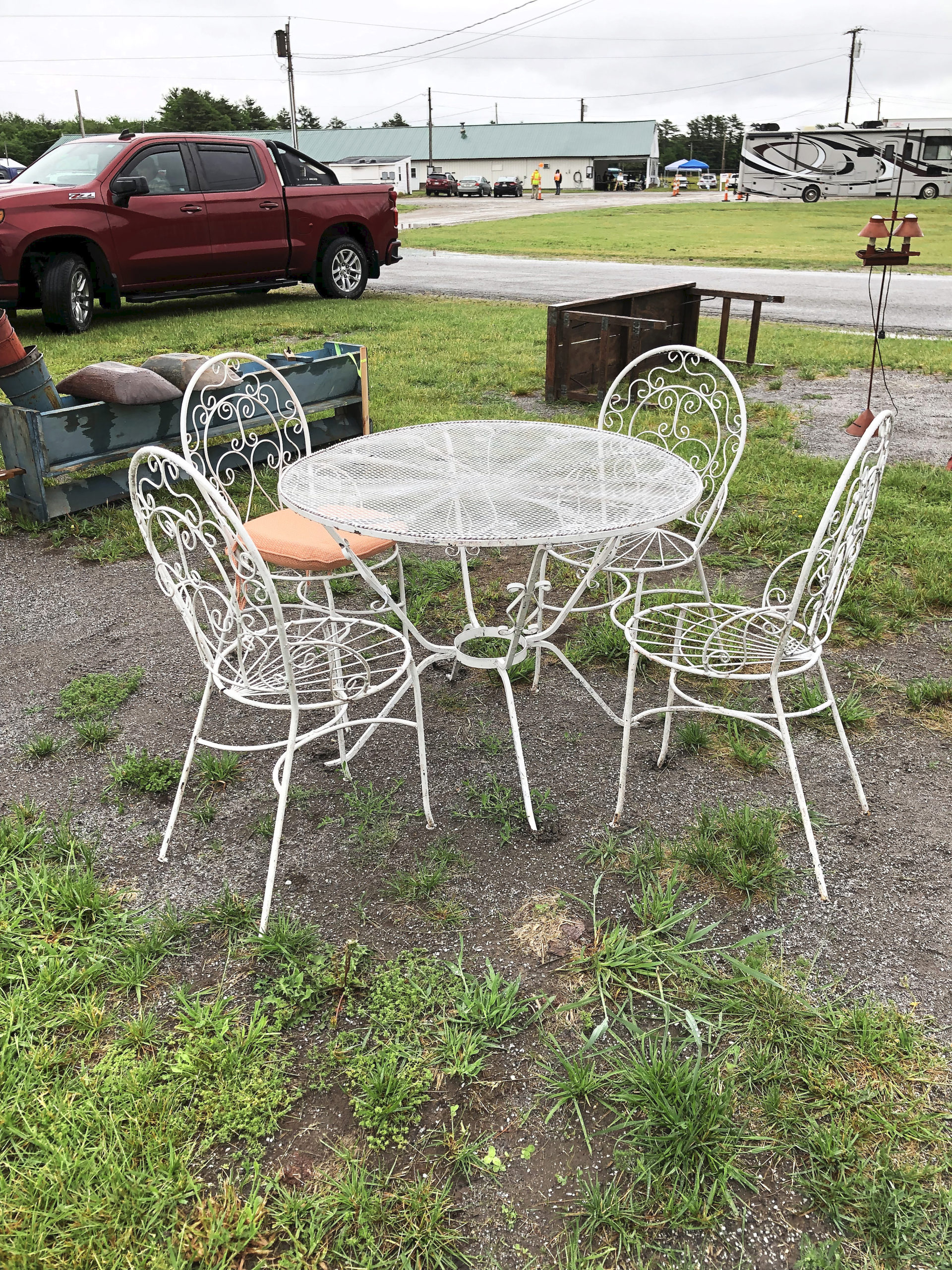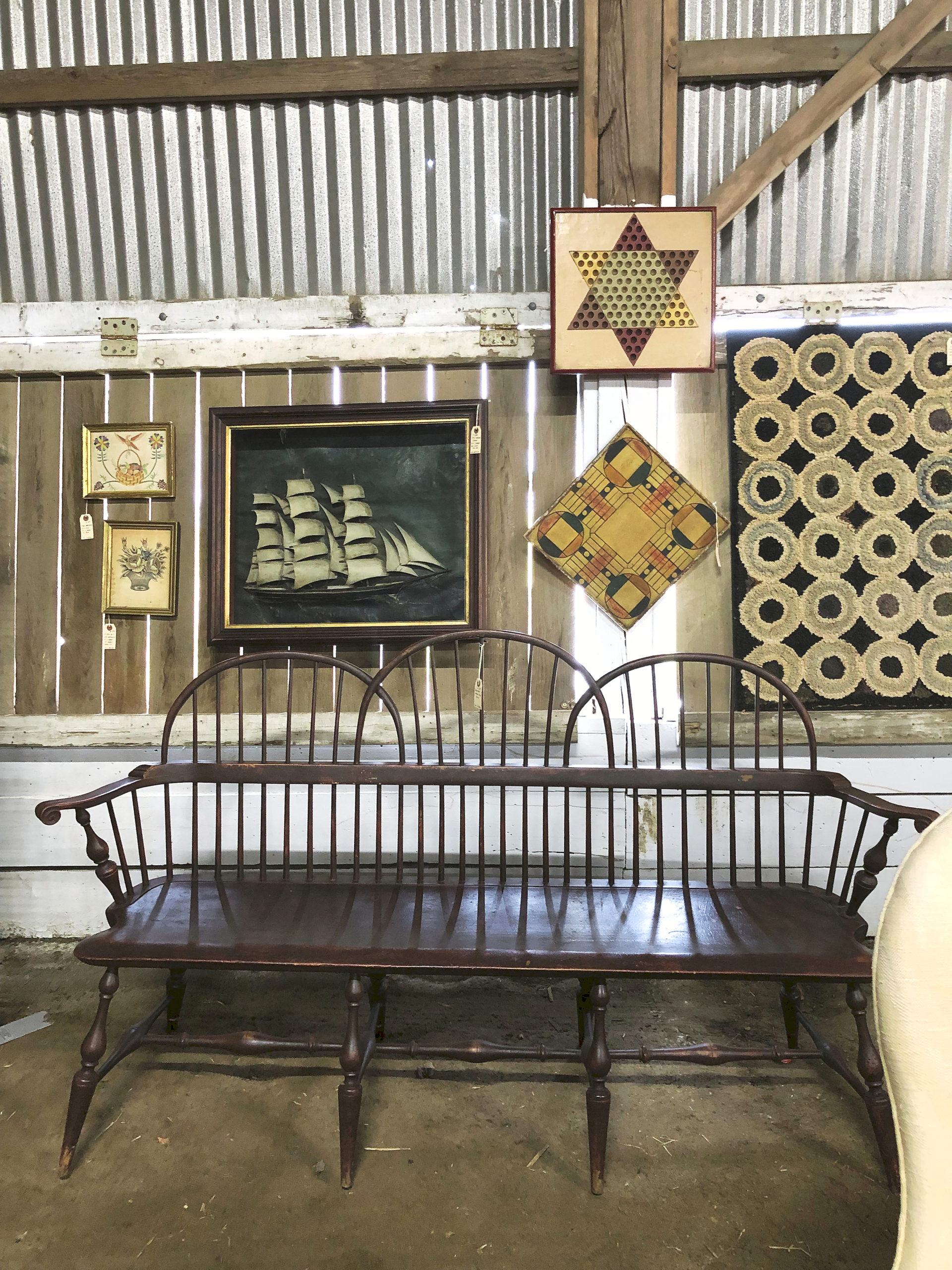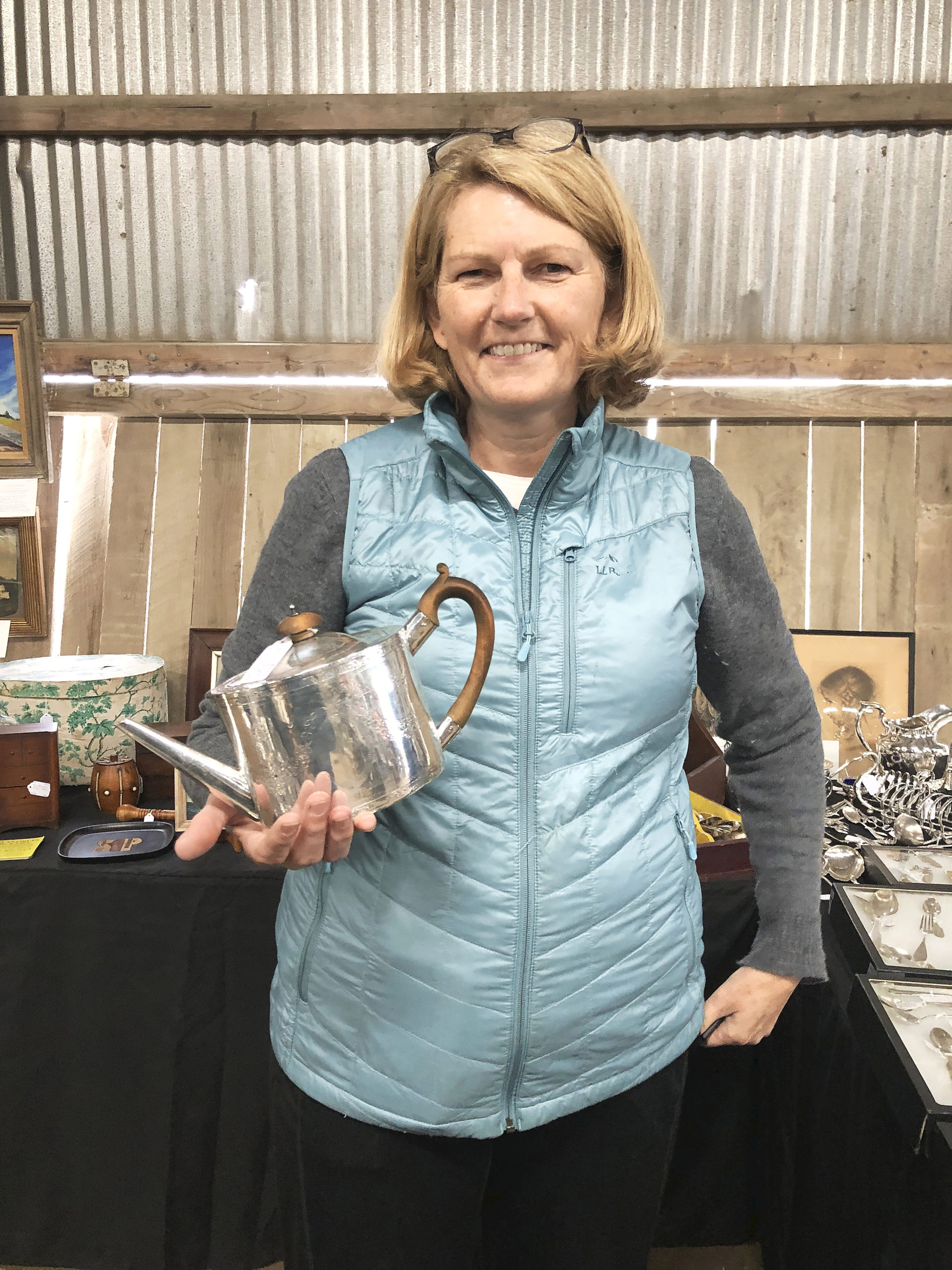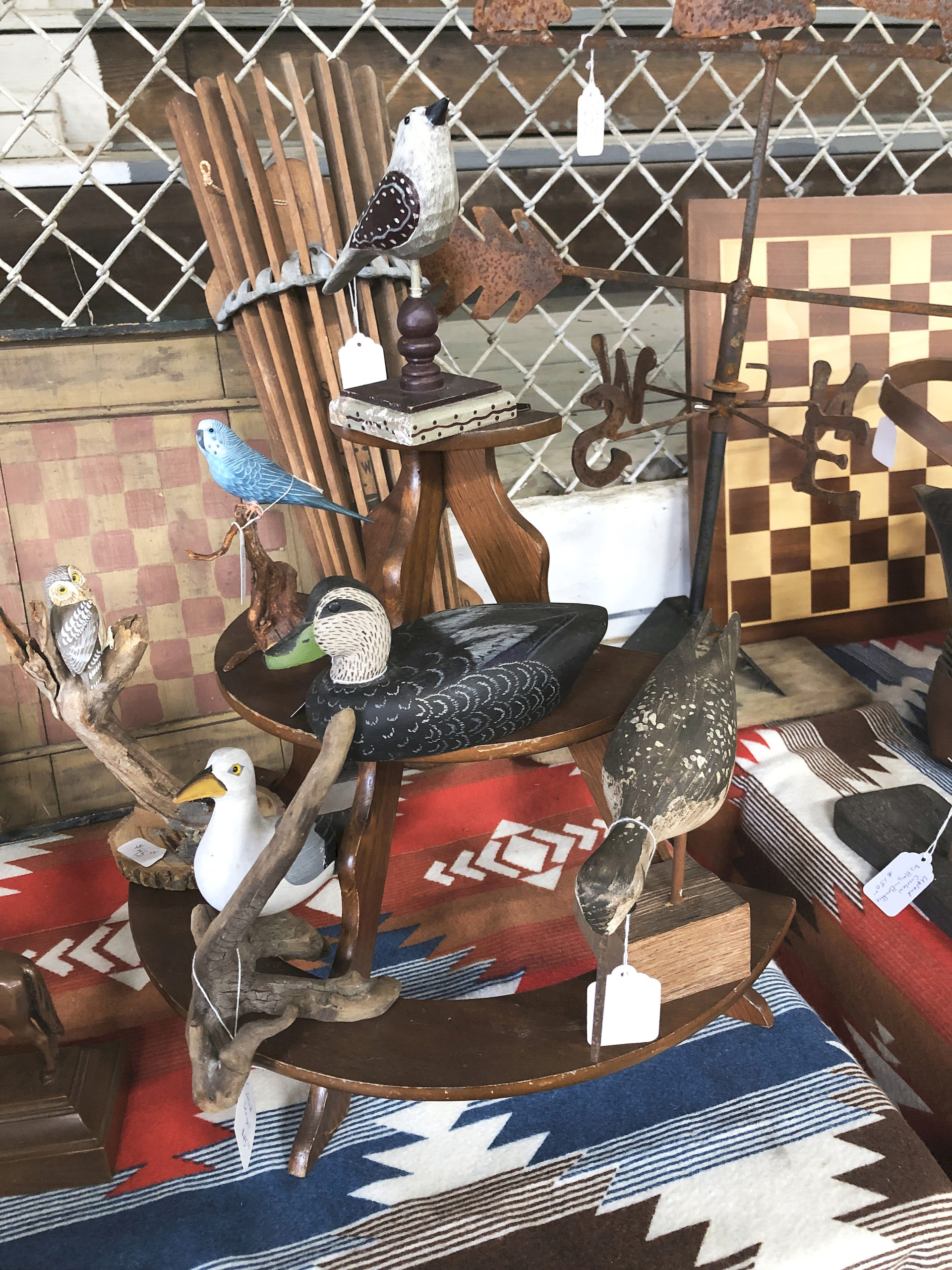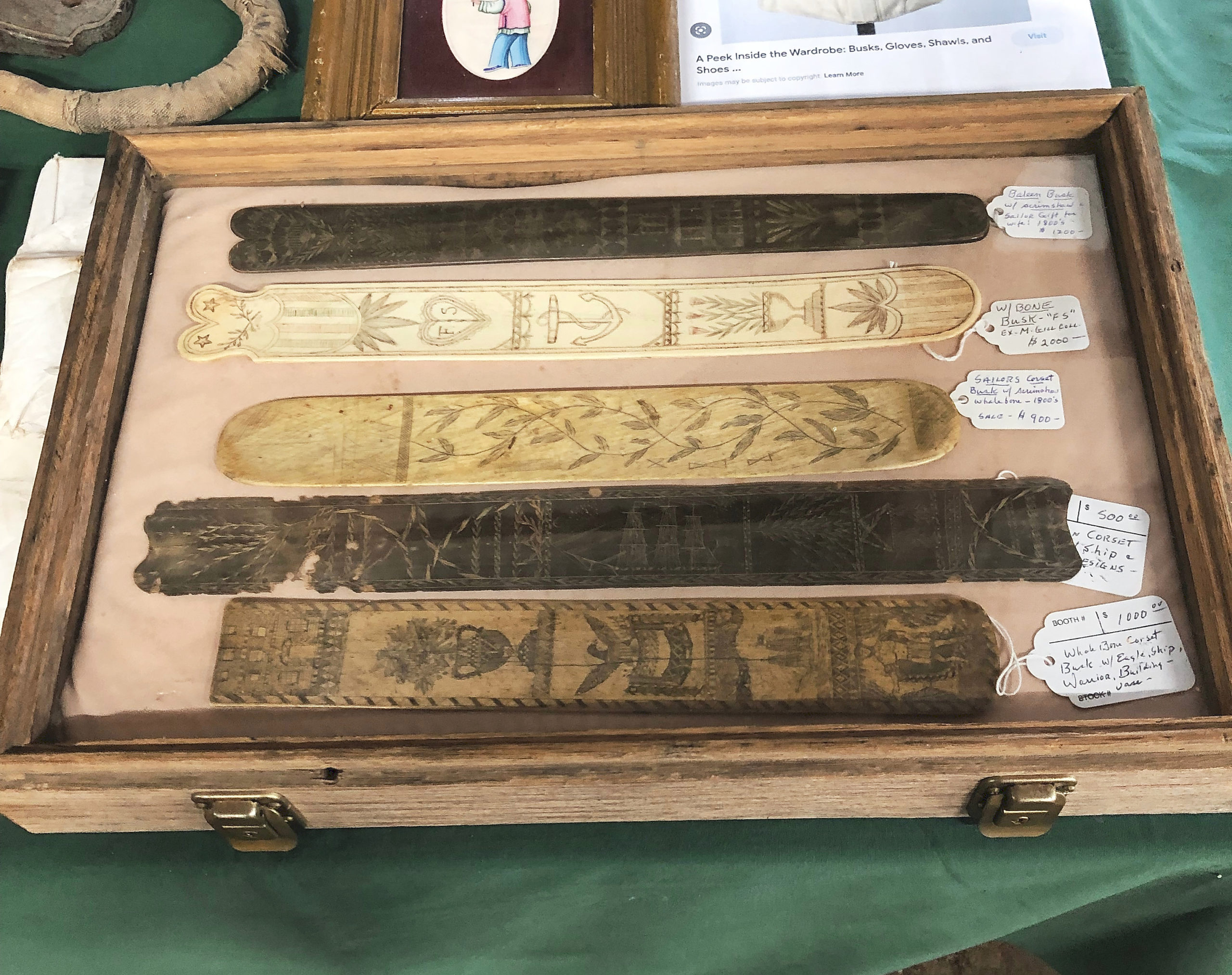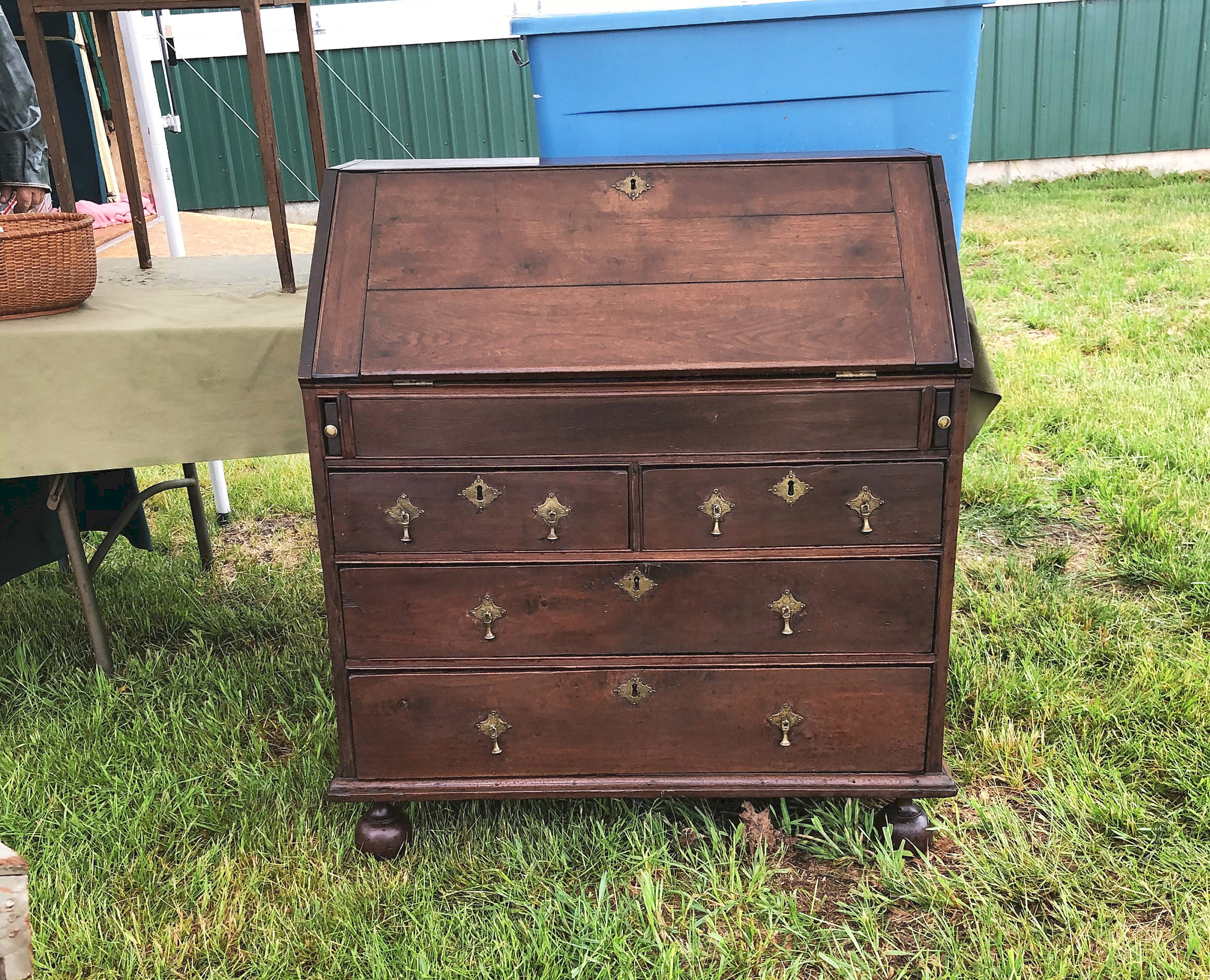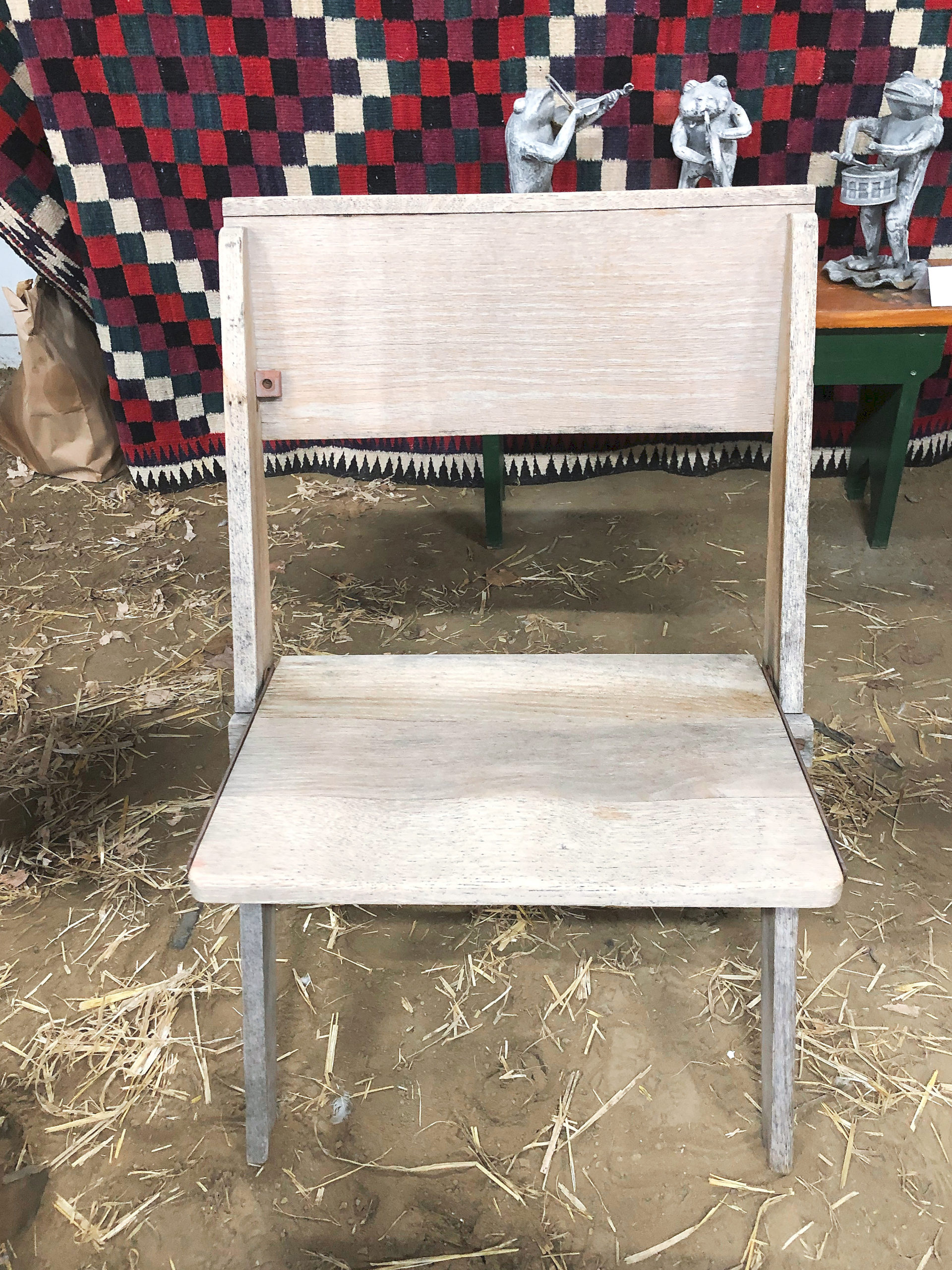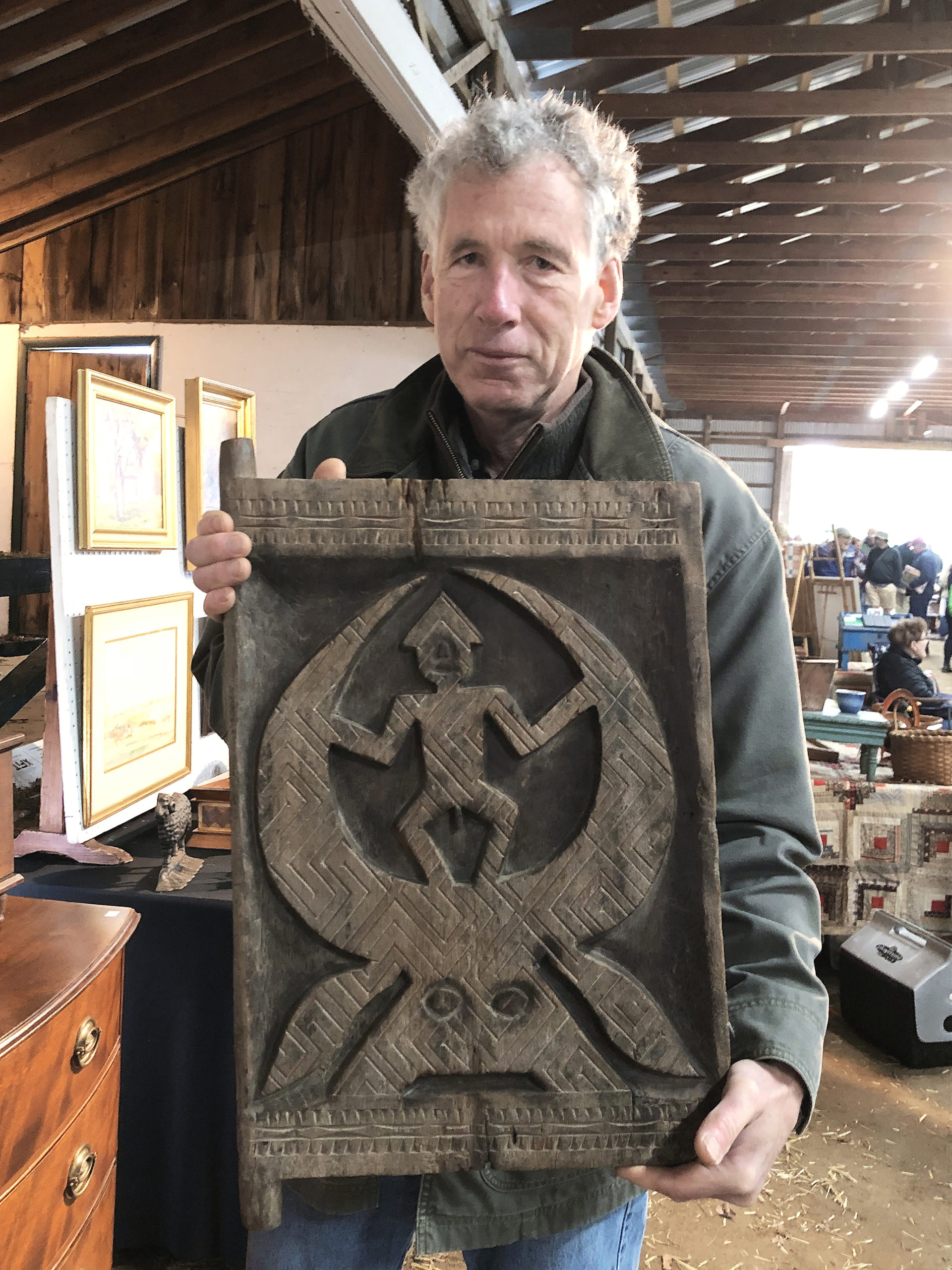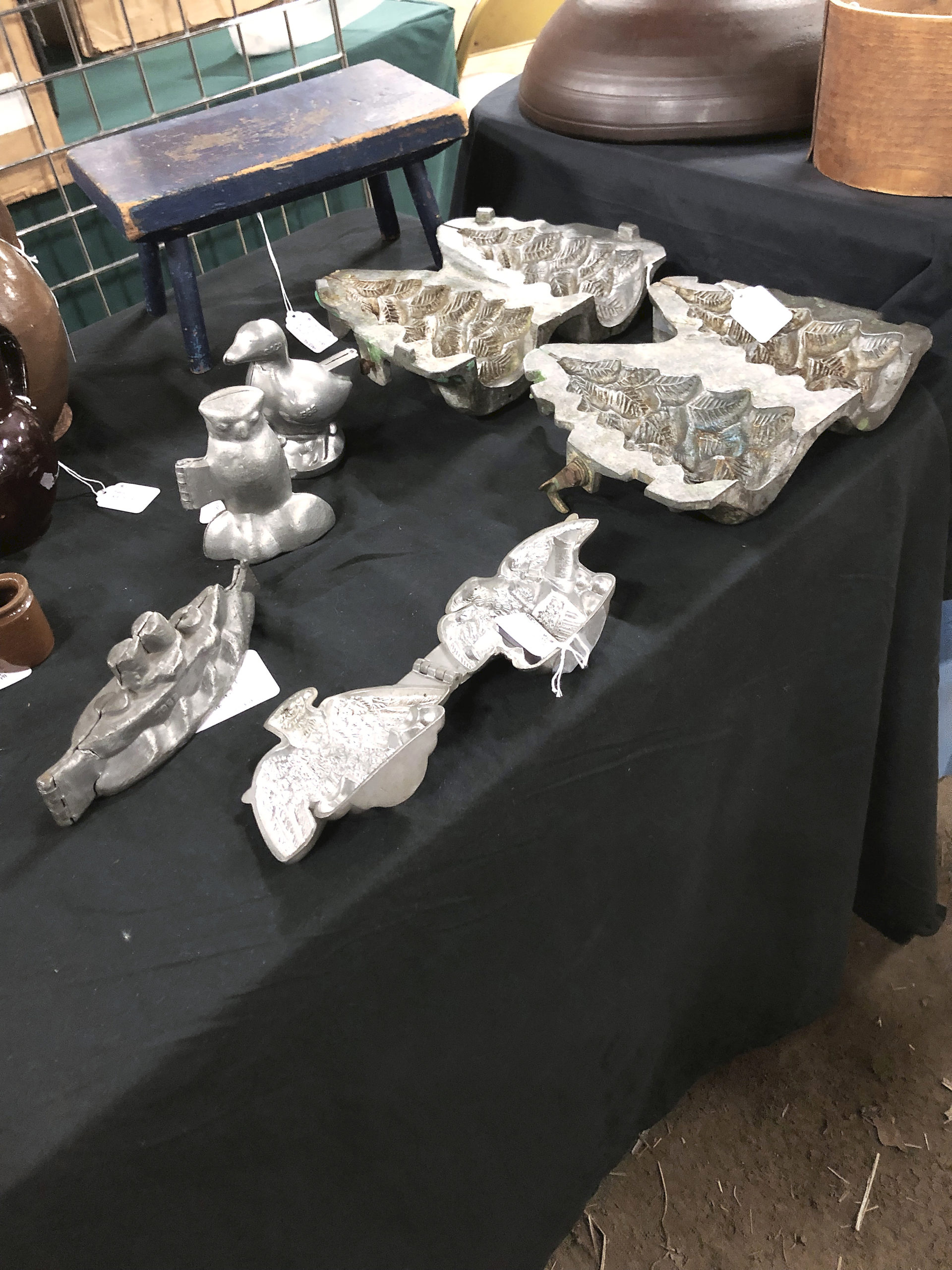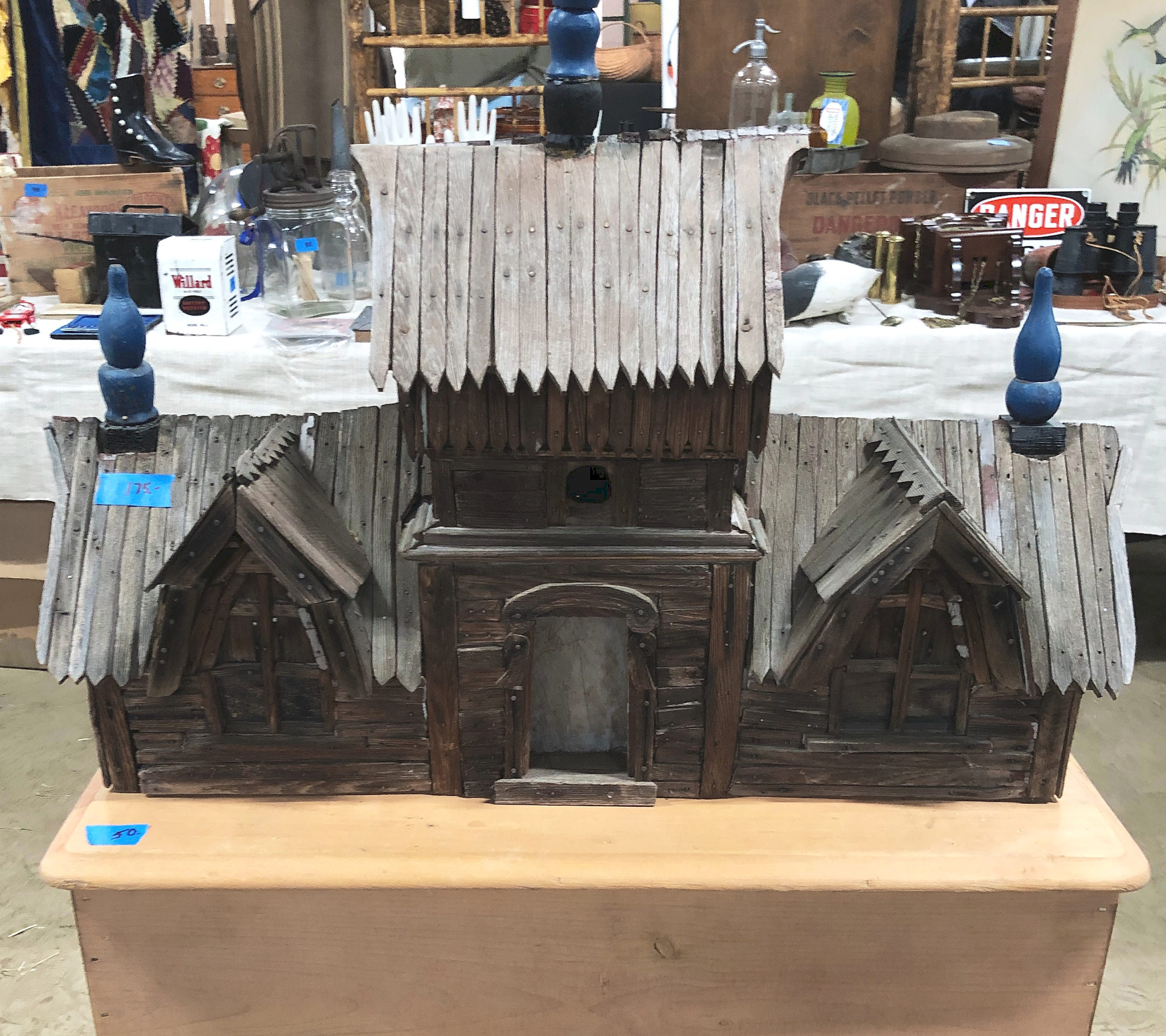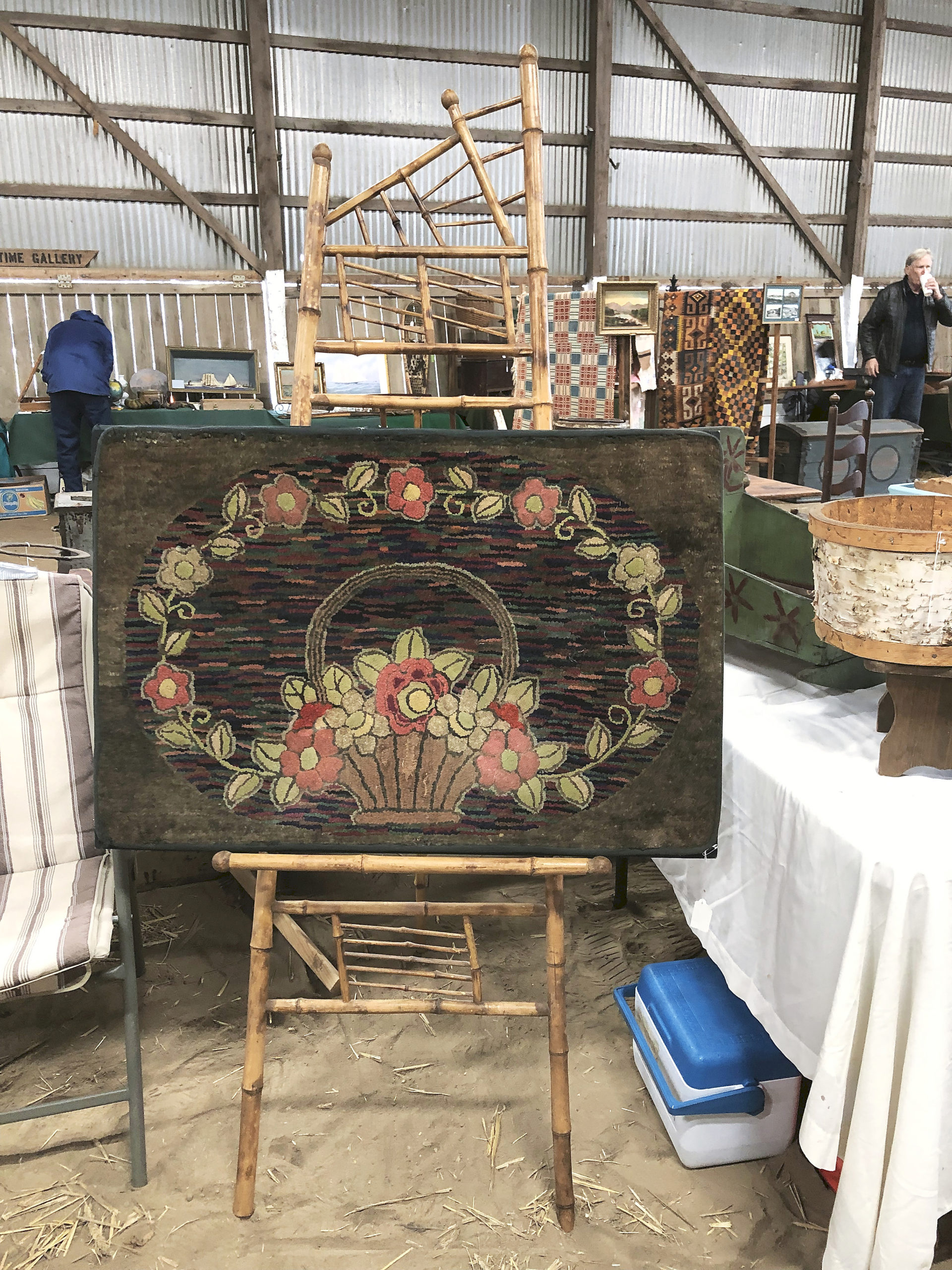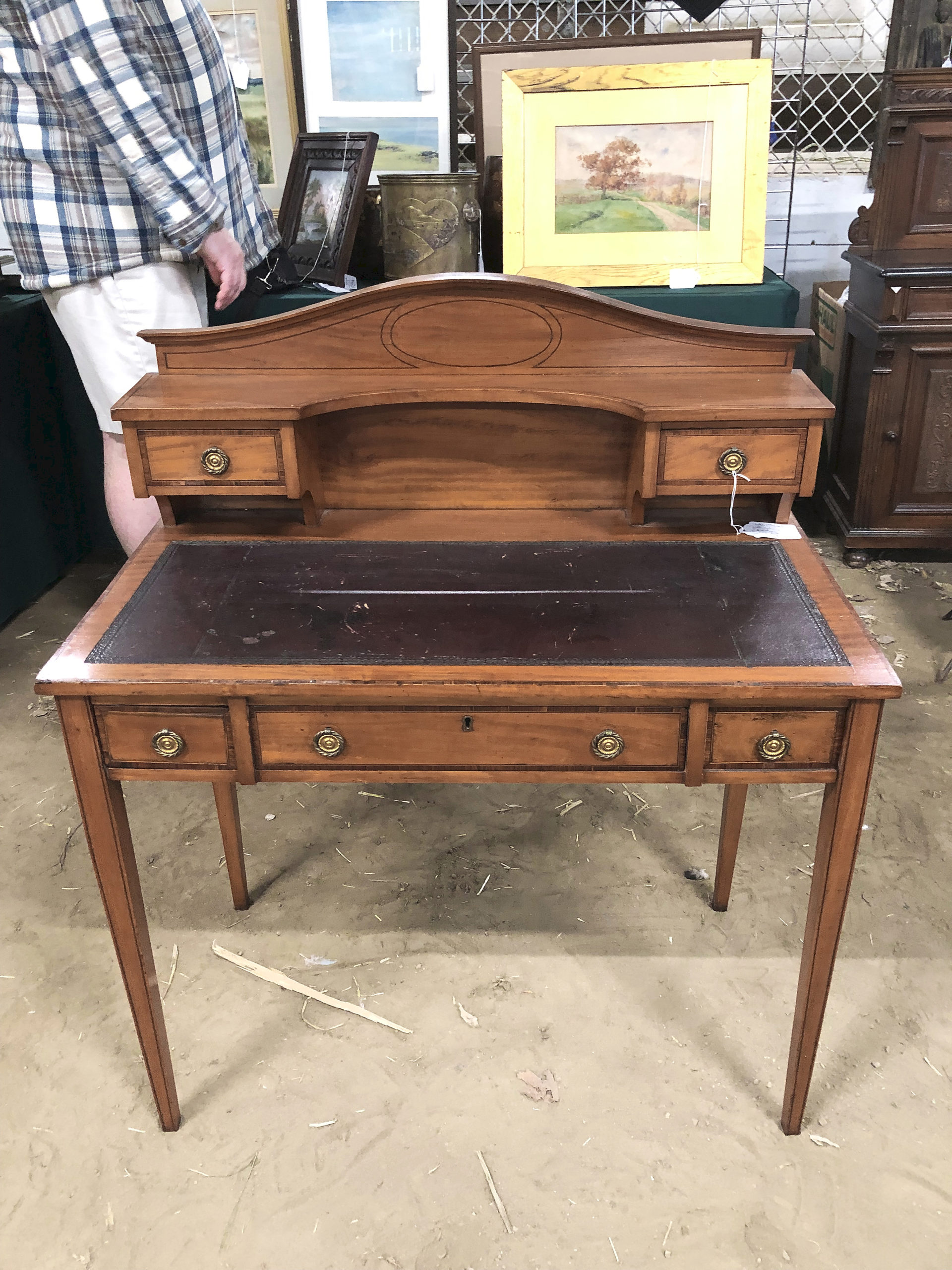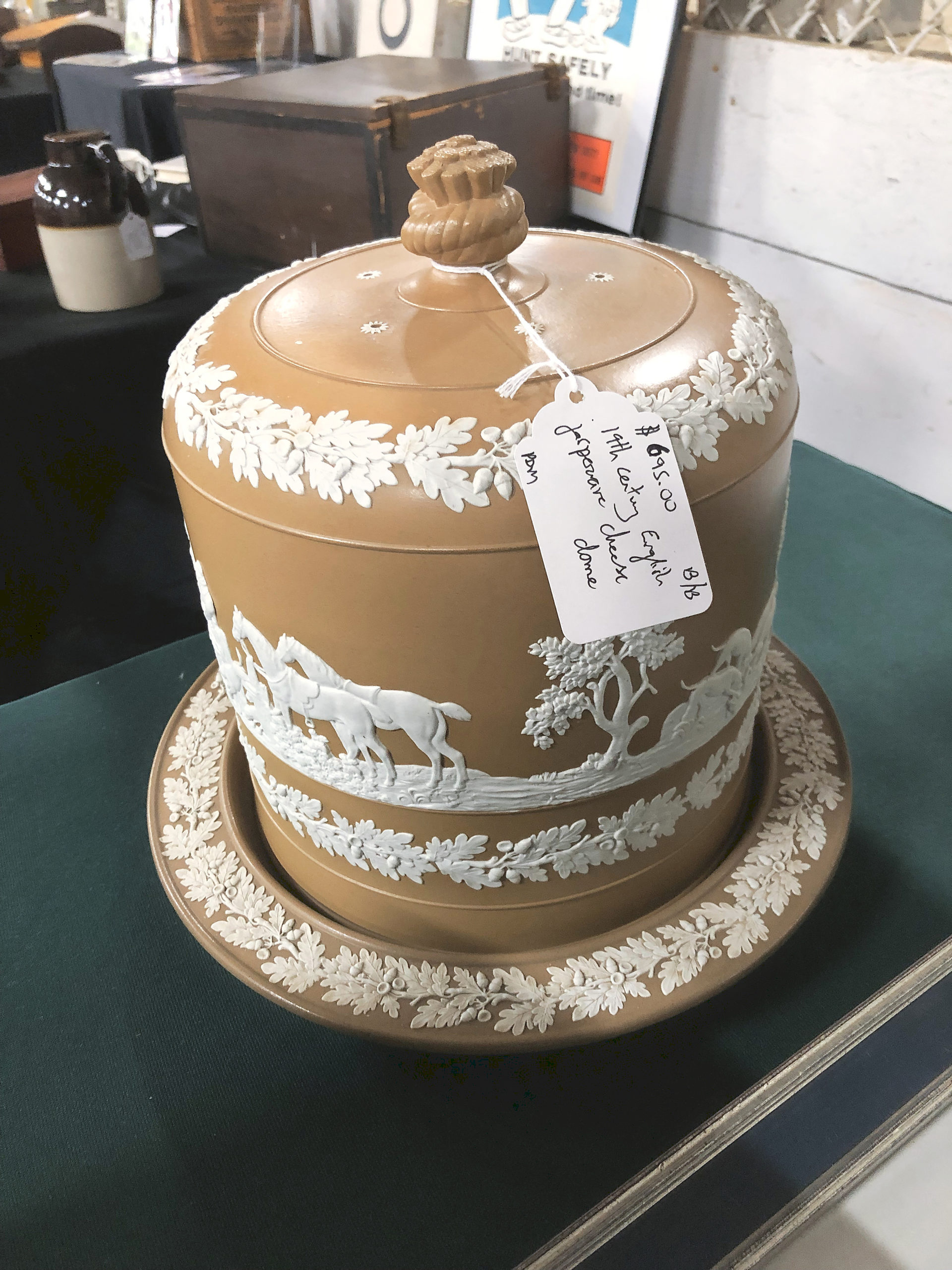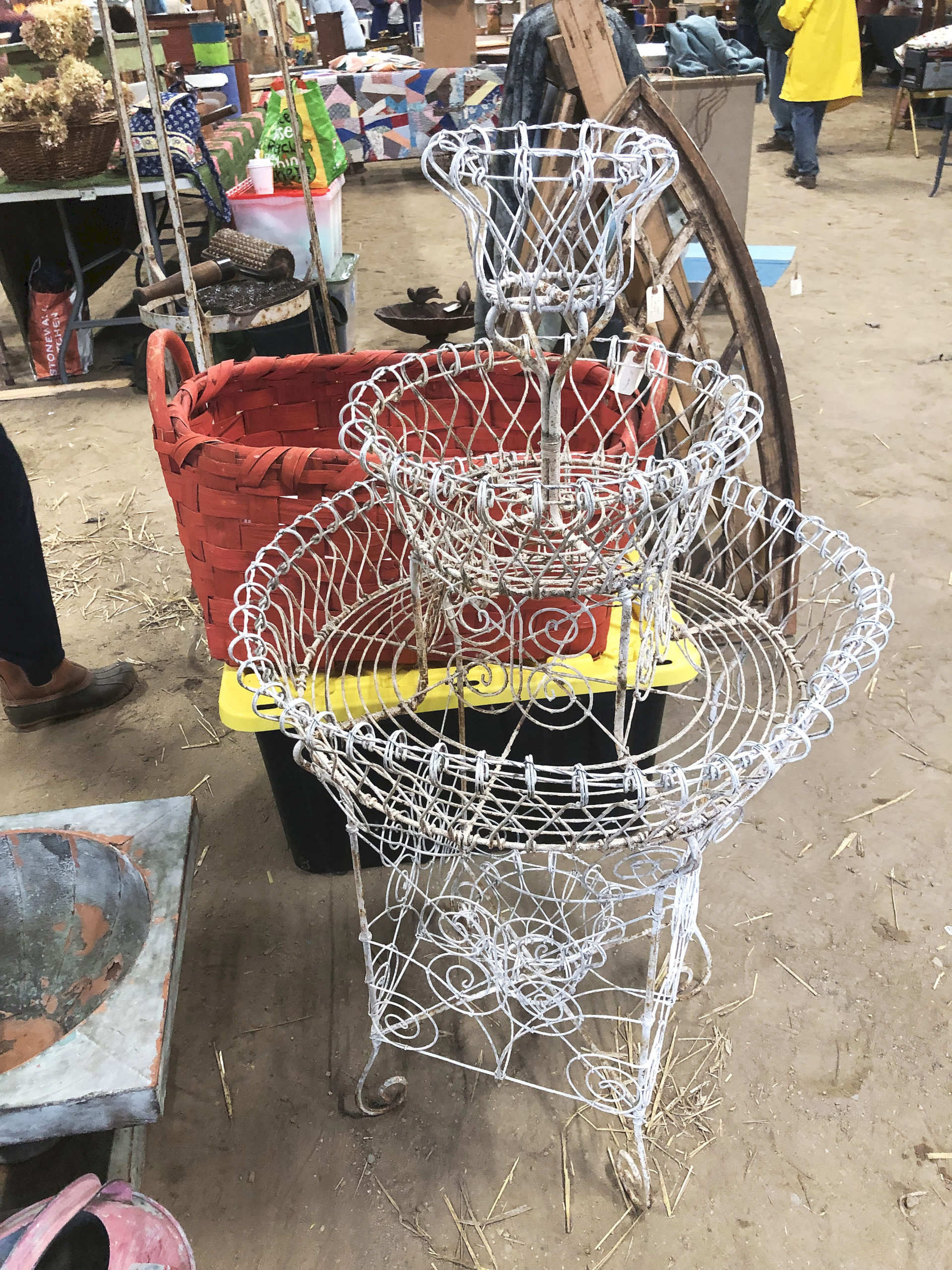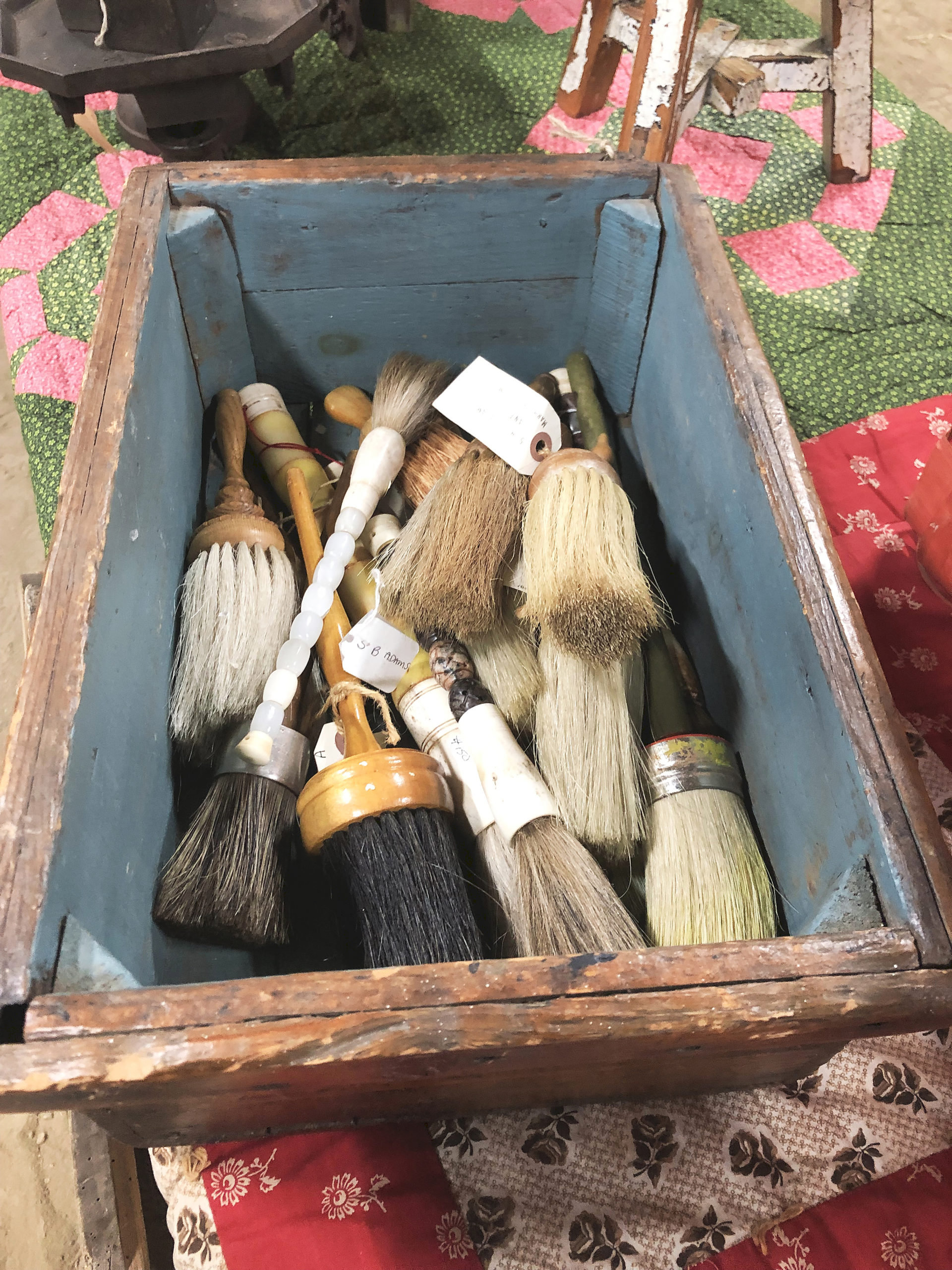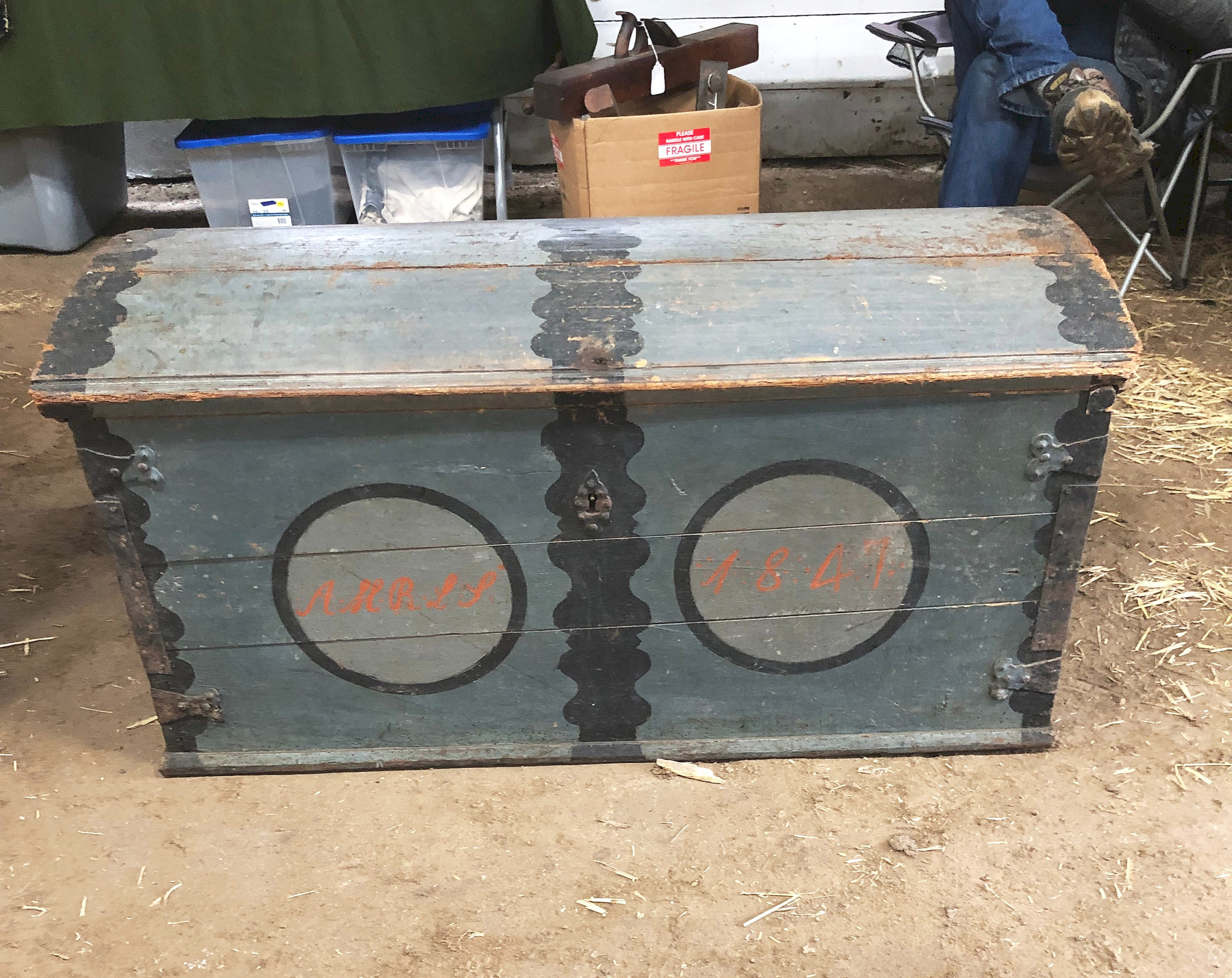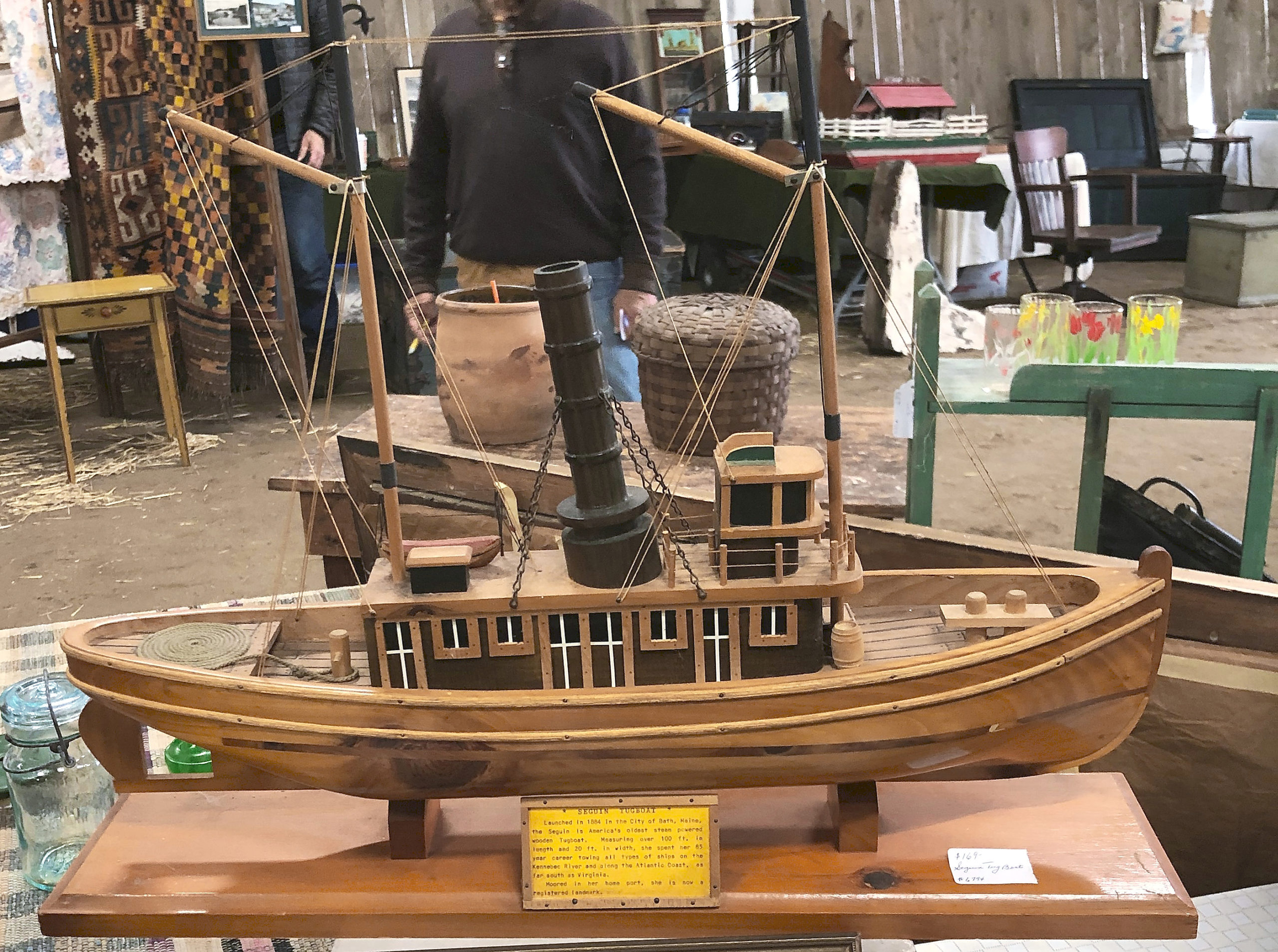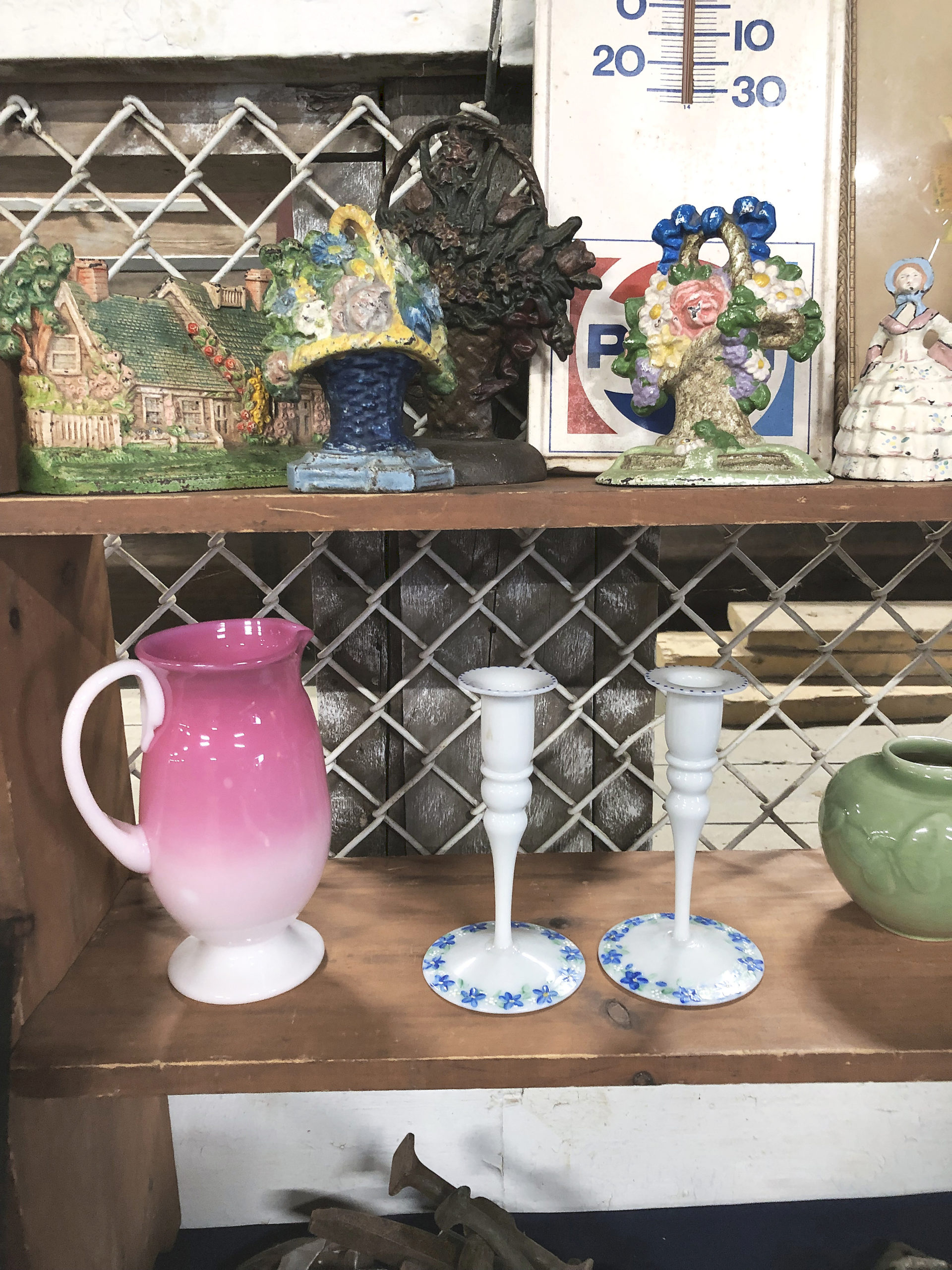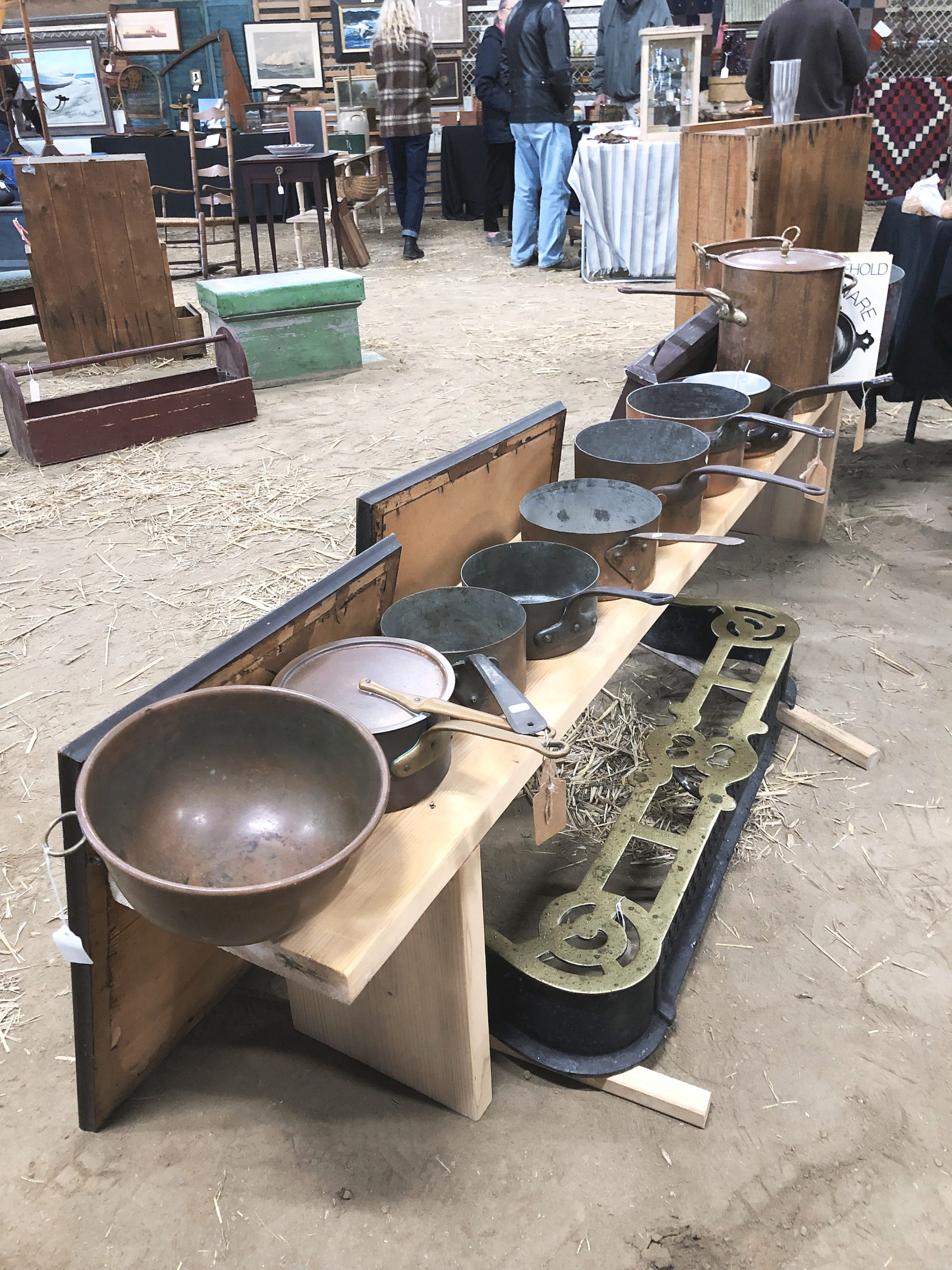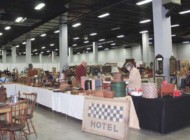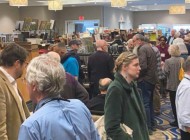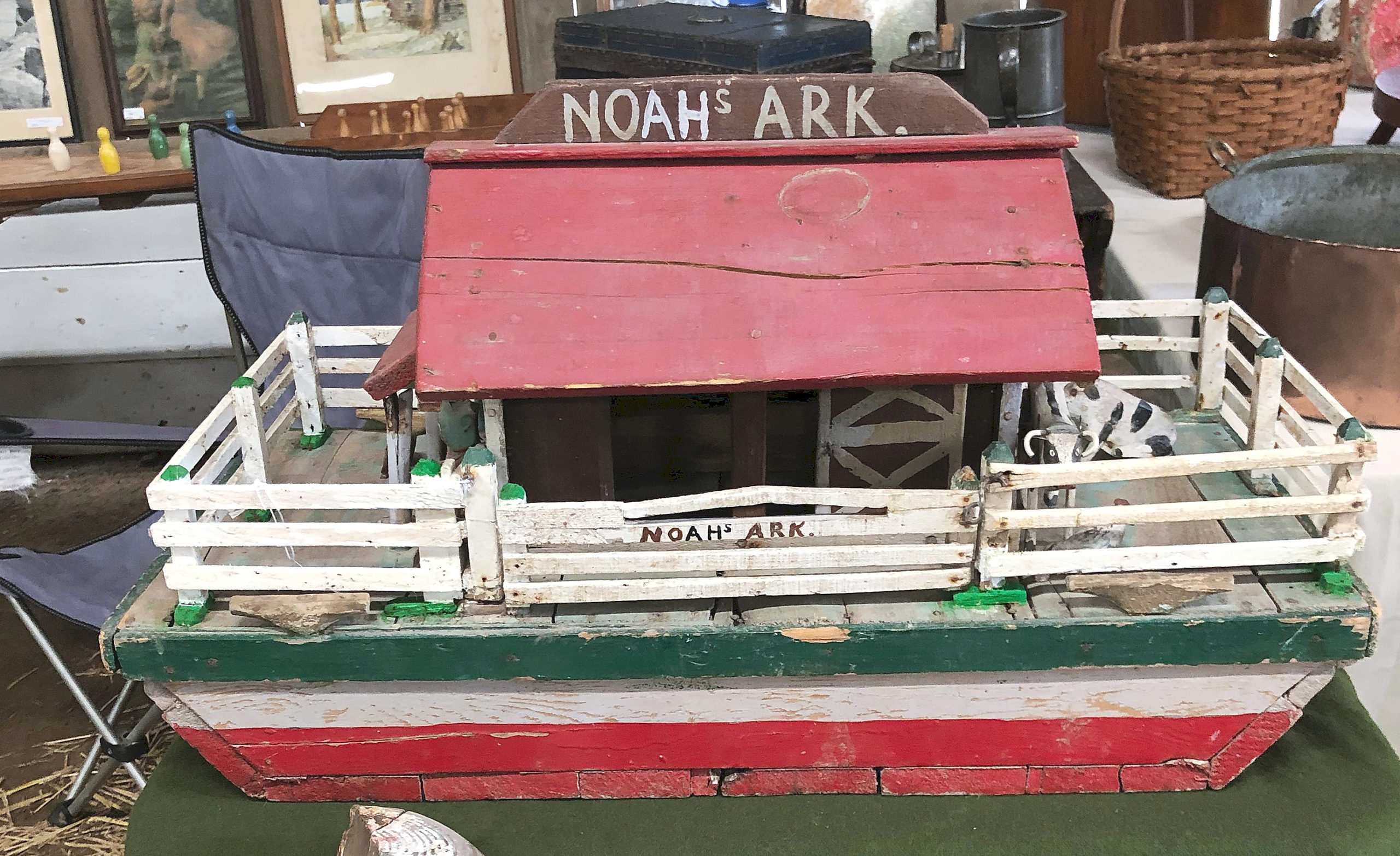
This Noah’s Ark was, as described by Chris Stanley, Bremen, Maine, as a true example of Maine folk art. The ark was in the form of a barge, and it had six carved figures. Five were identifiable but one was a polka dot figure with a longer than usual neck. It might have been a giraffe; the price was $575.
Review & Onsite Photos by Rick Russack
TOPSHAM, MAINE — Friday, June 2, felt like summer. Saturday, June 3, the day of the Maine Antiques Dealers Association (MADA) show, felt more like early spring: cold, rain on and off and windy. But the MADA show at the Topsham fairgrounds went on, as it has for the last few years. The association has about 130 members and may be one of the oldest antiques dealers’ associations in the country.
Most dealers were under shelter, as John and Liz DeSimone, who help manage the show for the association, had arranged to use one of the fairgrounds buildings, just in case. Three hardy dealers chose to set up outside that building. Americana is the flavor of the show but there’s more to it. At least three dealers included specialized collections in their booths: mackerel plows, engraved whale busks, and a collection of brushes for different uses. In addition, there was early furniture, Midcentury Modern, Maine-related artwork, silver, stoneware, redware, nautical antiques and bird carvings.
Pam and Gordon Stanley, Sedgwick, Maine, deal under the name Maritime Gallery. Gordon has been collecting, cataloging and preserving a little-known artifact of Maine’s fishing industry: mackerel plows. You may very well have seen some of them — a knife with a very short blade, set it in a wooden handle of varying degrees of ornament — but didn’t know what they were. They were used on Nineteenth Century mackerel schooners to enhance the marketability of certain mackerel. As the story goes, mackerel caught at the beginning of the season — spring and early summer — tended to be lean, dry and tough. They would not bring as much money as a more plump fish. Enterprising fisherman learned that with a few strokes of these implements, they could open up the fish, exposing the flesh, which would then swell, making the fish look fatter. Almost always handmade, each fisherman had their own. As with many other everyday objects, some are truly examples of folk art and can reflect the interests of their owners. Some were inlaid with pewter, some with stars and some were carved with elaborate, open handles. Others had Masonic imagery. Gordon Stanley said that he had about 100 and decided it was time to sell them. He had two cases of them at the show, with prices ranging from $100 to $750 for the “folky” examples. His collection had been the subject of several articles over the years and had been displayed at the Maine Maritime Museum in 2006.
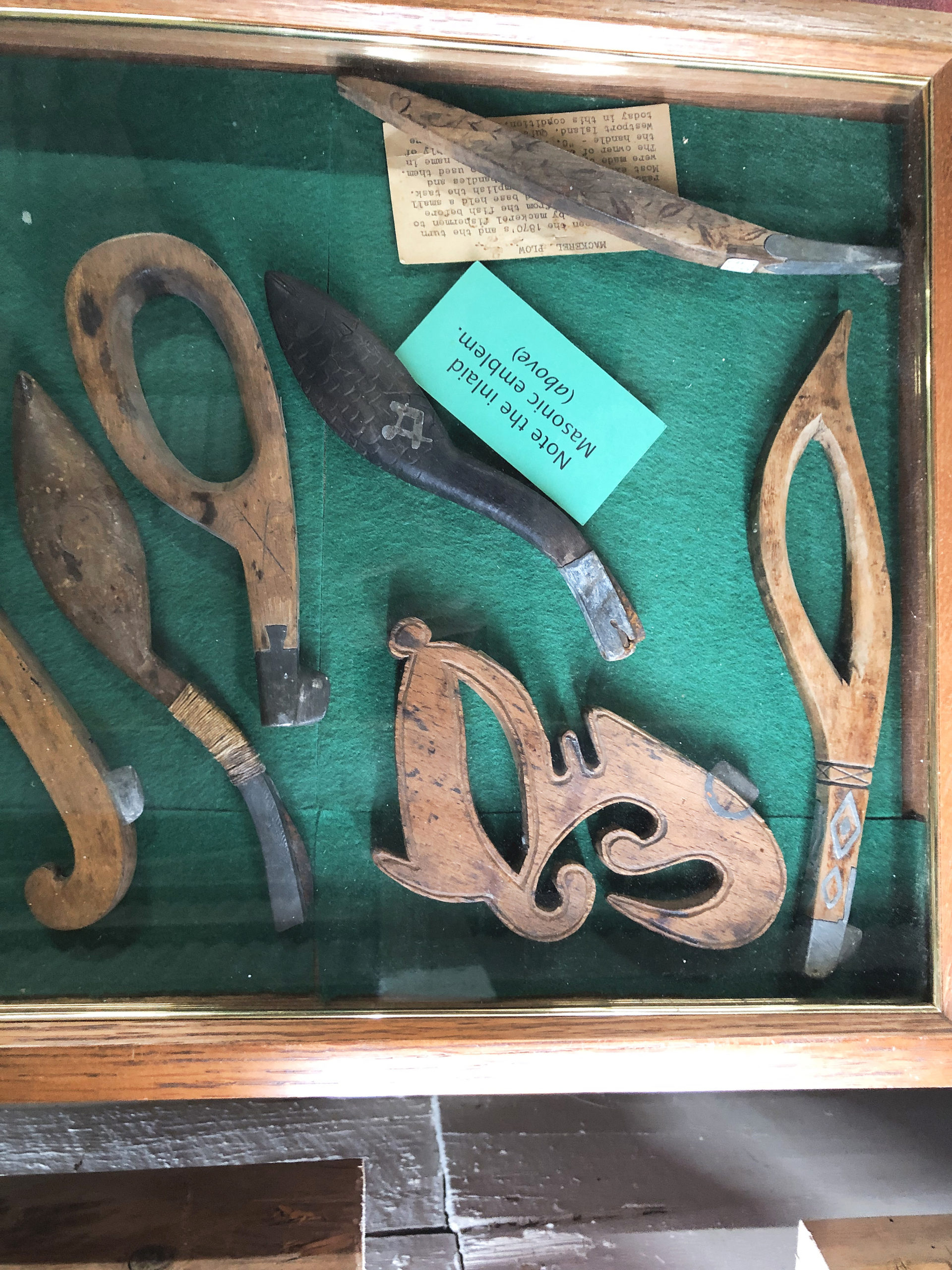
Gordon Stanley, Sedgewick, Maine, has a collection of more than 100 mackerel plows. He has decided it’s time to part with the collection, which had been exhibited at the Maine Maritime Museum. Many were decorated, some with Masonic symbols, and they were priced between $100 and $750.
Stanley was also dispersing a long-time personal collection of engraved whalebone busks. Made by sailors on whaling voyages, they reflected differing levels of skills and a wide variety of subject matter. The most expensive one he had at the show — priced $2,000 — included a ship’s anchor, a heart enclosing the letters “F” and “S,” with a shield with a floral design and other floral features. His least expensive, a baleen example that was not in great condition, was marked $500 as it had an engraving of a sailing ship. Another had a spread-winged eagle. He also had a highly detailed diorama of a four-masted sailing ship, with a dock and lighthouse.
In addition to having the largest selection of silver at the show, Deirdre O’Callaghan, Partridge Hill Antiques, Georgetown, Maine, had an interesting watercolor of a seaside scene, possibly of Boothbay Harbor. It had been done by Deane W. Keller (1901-1992), who taught at Yale University’s School of Fine Arts for more than 40 years and summered in Boothbay Harbor. Keller was one of the “Monument Men,” a group more properly known as the Monuments, Fine Arts and Archives program of the Allies. Keller was in active service between 1943 and 1946. Their story was the subject of a book, The Rape of Europa by Lyn Nicholas and another by Robert Edsel as well as the subject of a 2014 movie based on Edsel’s book, The Monuments Men. The work of that small group of men and women is credited with recovering thousands of artworks confiscated in Nazi Germany. O’Callaghan priced the watercolor at $425.
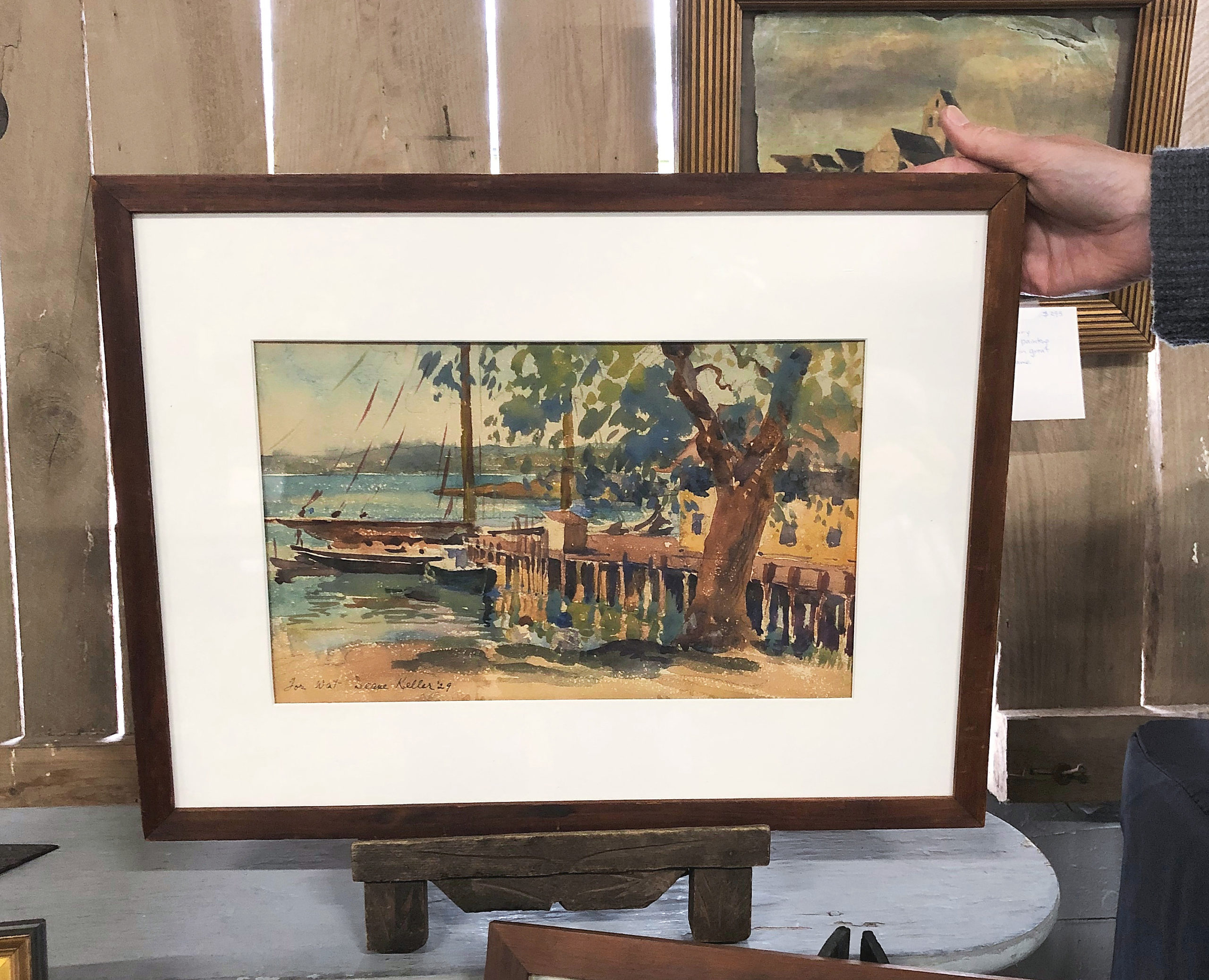
A watercolor, possibly of Boothbay Harbor, had been painted by Deane W. Keller who had been a member of the “Monuments Men’ active at the end of World War II, recovering artwork looted by the Nazis. The painting was priced $425.
Susan Sorrentino, Westport Island, Maine, had a collection of brushes of the type often seen, with different types of bristles set into wooden handles. When asked what they were used for, her answer was surprising, reflecting the specialized needs of artists and homemakers. Some were Shaker made, some were used when cleaning dust from applying stencils, some were used when applying varnish and some were used for general household dusting and cleaning. Prices ranged from $55 to $110.
There were several wooden ship models. Bruce Trumper, Belgrade, Maine, priced a model of the tugboat Seguin at $169. The tug was launched in 1884, was named for Seguin Island at the mouth of the Kennebec River and spent her first 20 years pulling ships up that river and later worked as far south as Virginia. It was retired in 1967 and the Maine Maritime Museum planned to restore it. However, they determined the tug was in very poor condition, and scrapped the project but kits and models of the Seguin are still being made today.
Although most of the furniture offered was from the Nineteenth Century and American in origin, or least inspired by those forms, there was some midcentury and other furniture in the building. Joni Lima and Joe Spaider, Round Pond, Maine, had a set of four circa 1950 “Cantina” folding chairs signed “Hagar” priced at $395. Bill Gittes, Barrington, N.H., had several pieces of Adirondack furniture, including a mirror framed in birch bark, complete with antlers. Perhaps one of the earlier pieces at the show was under the tent of one of the dealers who had chosen to set up outside. Hilary Nolan, Falmouth, Mass., had a circa 1740 cedar and walnut slant front desk which he thought showed characteristics of having been made either in Philadelphia or Massachusetts. It was priced $4,500. He had several other pieces with original surfaces, including a large, hooded cradle.
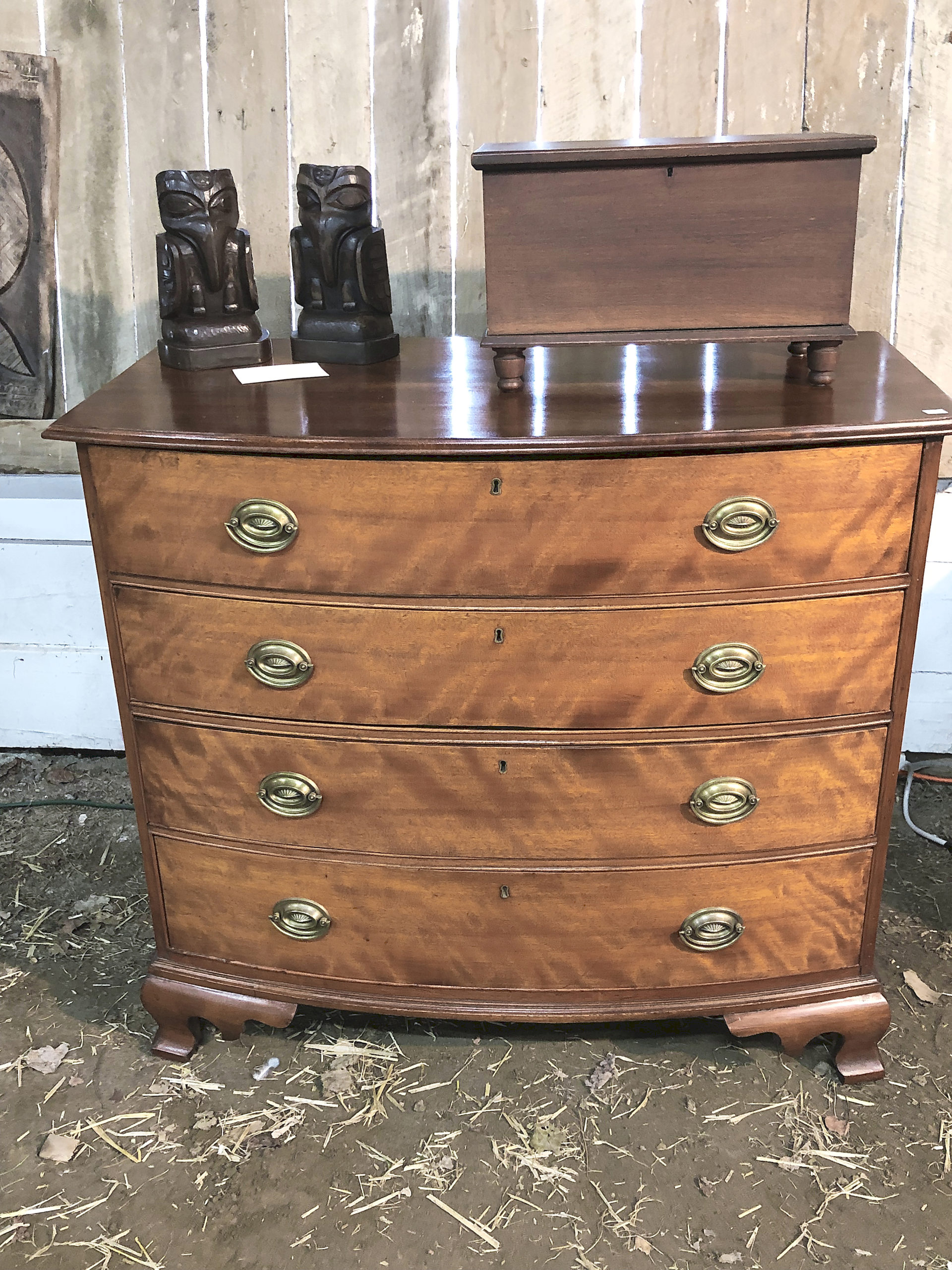
Martin Ferrick, Lincolnville, Maine, always has a selection of early furniture, ready for use in almost any home. This four-drawer bow-front chest was priced $1,800.
Martin Ferrick, Lincolnville, Maine, offered a four-drawer bowfront chest for $1,800. Shortly after the show opened, a smoke-decorated pedestal table in his booth had a sold tag. Chris Stanley, Bremen, Maine, had a large blue-gray painted Scandinavian dome-top chest, with heavy, forged iron handles that was dated “1847” on the front; he was asking $425. A painted benchmade Windsor bowback settee in the booth of Dennis Raleigh/Pumpkin Patch Antiques, Searsport, Maine, had a three section back and turned legs and arm supports; it was priced $2,650. An Edwardian lady’s writing table, on inlaid tapered legs in the booth of P.D. Murphy, Bath, Maine, was priced $350. Murphy also had some almost matching rod-back Windsor side chairs, each of which he was asking $75.
Garden furniture included a round iron table with four matching chairs. Bob Foley, Gray, Maine, was asking $450 for the circa 1940-50 set. Susan Sorrentino exhibited a large, three level round wire plant stand that was tagged $695.
After the show, John DeSimone said, “In spite of the unseasonable weather, the show went well. Unfortunately, the fairgrounds was also being used at the same time of our show by a Monster Truck rally, and that complicated access to the show for some of our customers. We were not aware of that, and we’ll be sure that it won’t happen again.”
The DeSimones’ Goosefare Promotions run about a dozen shows a year. For information, www.goosefareantiques.com or 800-641-6908.

